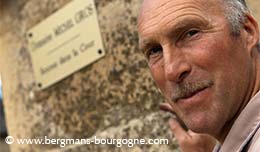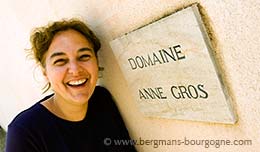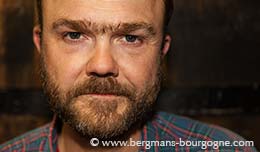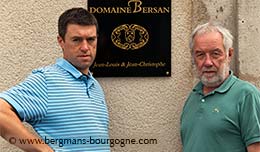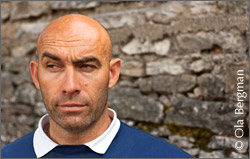
annick Jacrot, winemaker at Domaine Chapelle in Santenay, has solid experience of organic viticulture. Throughout his whole career this has been his main focus.
– All domaines where I have worked have been organic, he says. Before converting to organic viticulture there is a lot you need to learn. Many talk about being organic; they plough the vineyards, but they use chemical treatments. If you are going to do it properly you need to take in a lot of knowledge.
– For me organic wine-growing is about caring for the well-being of the vines and respecting the environment. In addition, this respect for the vines provides you with grapes of greater depth and complexity, with higher density and a higher skin to juice ratio.
 Yannick Jacrot arrived at Domaine Chapelle just in time for the 2002 harvest. The domaine is located in the part of the village called Santenay-le-Haut, upper Santenay, just above the lieu-dit Clos des Cornières.
Yannick Jacrot arrived at Domaine Chapelle just in time for the 2002 harvest. The domaine is located in the part of the village called Santenay-le-Haut, upper Santenay, just above the lieu-dit Clos des Cornières.
– The first parcel was converted to organic viticulture in 2003. The year after almost the entire domaine had been converted. In 2006 we applied for certification. Becoming certified is a long process. It takes three years from handing in the application until you can put the logo on your labels.
– Before coming to Domaine Chapelle I stayed two years at Domaine Jean-Jacques Confuron in Prémeaux-Prissey and then two years at Domaine Féry in Echevronne, which was connected to Domaine JJ Confuron at the time. Then I spent some time at Domaine de La Pousse d'Or in Volnay.
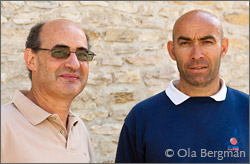 – It was thanks to my supervisor in Prémeaux-Prissey that I discovered organic wines. The domaine was working organically and ever since I have too. And thanks to this I got the job at Domaine Chapelle converting it to organic viticulture.
– It was thanks to my supervisor in Prémeaux-Prissey that I discovered organic wines. The domaine was working organically and ever since I have too. And thanks to this I got the job at Domaine Chapelle converting it to organic viticulture.
Yannick Jacrot is happy with the results at Domaine Chapelle. Working organically means you are surrounded by many regulations. There is a lot more work required, making it more expensive. He points out that working organically does not automatically lead to excellent wines. There are good organic wines and there are bad organic wines, and there are also good wines that made traditionally.
 For the past four generations the domaine has been in the Chapelle family.
For the past four generations the domaine has been in the Chapelle family.
– But the first traces of the domaine can be found already in 1730, says Yannick Jacrot. In 1923 it was also the first domaine in Santenay to start bottling their own wine.
It was Dr Chapelle who bought the domaine in 1908. Back then it was called Domaine des Hautes Cornières. 24 years later the doctor's nephew, Philippe Chapelle, took on the domaine and with the arrival of Roger Chapelle, Philippe Chapelle's son, in 1953 the number of hectares under vines began to grow.
– The Aloxe-Corton and Ladoix part of the domaine comes from the acquisition of another domaine made by Roger Chapelle in the 1970's. In total five hectares were added to the domaine. Six parcels in Ladoix.
 Today's owner Jean-François Chapelle joined his father in 1987 and two years later Domaine Chapelle was created. Unfortunately Roger Chapelle passed away quite young leaving Jean-François in charge of things in 1989. Three years later, in order to diversify the wine portfolio, the domaine began buying must from other growers. Initially only for white wine, but from 2002 also for reds such as Beaune, Volnay, Gevrey-Chambertin, Corton and Charmes-Chambertin.
Today's owner Jean-François Chapelle joined his father in 1987 and two years later Domaine Chapelle was created. Unfortunately Roger Chapelle passed away quite young leaving Jean-François in charge of things in 1989. Three years later, in order to diversify the wine portfolio, the domaine began buying must from other growers. Initially only for white wine, but from 2002 also for reds such as Beaune, Volnay, Gevrey-Chambertin, Corton and Charmes-Chambertin.
In total Domaine Chapelle covers 20 hectares. It is first and foremost a red domaine. Only a tenth of the production is white wine and the négociant business is relatively small, the equivalent of 1.25 hectares.
The Santenay appellation, squeezed in between Chassagne-Montrachet to the northeast and Cheilly-lès-Maranges to the southwest, covers 329 hectares (including 124 hectares of premier cru). It is mainly a red appellation, but 14 per cent of it is planted with chardonnay. There are premier crus on three sides of the village. One large chunk on the Chassgane-Montrachet side with premier crus such as Les Gravières, Clos de Tavannes, La Comme and Beauregard. One above the village consisting of La Maladière and Beaurepaire. And one on the Maranges side of the village with Grand Clos Rousseau and Clos Rousseau.
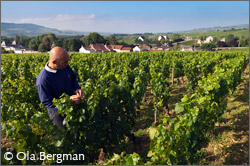 Domaine Chapelle has three different red Santenay premier crus – Les Gravières, La Comme and Beaurepaire.
Domaine Chapelle has three different red Santenay premier crus – Les Gravières, La Comme and Beaurepaire.
– Les Gravières is on calcareous soil with shale, explains Yannick Jacrot. This gives the wine a certain finesse and elegance, which makes it accessible sooner. In Beaurepaire we are closer to the rock. With less soil you get a wine with more structure and density. For La Comme the main difference is that the vines produce small grapes. The soil is thin and it always slightly cooler there.
For the future there is some white Santenay premier cru and some white Ladoix coming. These vines were planted in 2009, which means there is still some time left before we can expect some wine.
– White Santenay is much more mineral than a Chassagne-Montrachet or a Meursault, says Yannick Jacrot. The Chassagne-Montrachet has the fruit, the Meursault has the fat.
– I haven't tasted that many white Ladoix, but the ones I have had have been very good. For me it is an appellation that deserves a better recognition.
© 2011 Ola Bergman










